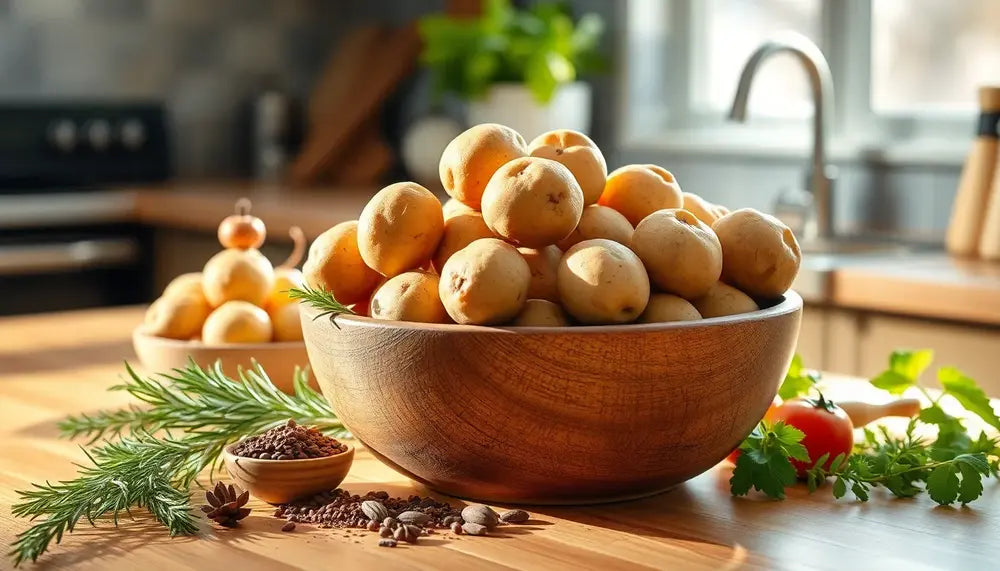Introduction
The Spice laurel is an integral part of Mediterranean cuisine. Its aromatic leaves add a distinctive touch to many dishes. Meat dishes in particular benefit from its intense taste and essential oils. In this article you will find out why Bay leaves are so popular, how to use them correctly and what benefits they offer for your kitchen.
Regardless of whether you are a beginner in the world of spices or have already gained some experience - this article will provide you with valuable tips and information on the topic Bay leaf spice. Immerse yourself in the world of Mediterranean flavors and discover how you can take your meat dishes to the next level.
What is laurel?
The Laurel, botanically as Laurus nobilis is an evergreen shrub or tree native to Mediterranean countries. The leaves of this plant are the real thing Spice, which is used in many kitchens around the world. They have a leathery texture and an intense, aromatic scent.
Botanical characteristics
The laurel tree can grow up to 10 meters high. Its leaves are dark green and shiny. During the flowering period from April to May, the plant produces small, yellowish flowers.
Essential oils and ingredients
The leaves of the laurel contain about 1.3% essential oil. This oil is responsible for the characteristic aroma and gives the dishes their distinctive taste.
| ingredient | quantity |
|---|---|
| Essential oil | approx. 1.3% |
| Fatty oil (in fruits) | up to 30% |
Cultivation and care
Laurel is relatively easy to care for and can also be grown in pots. It prefers sunny locations and well-drained soil. In colder regions it should be protected in winter.
- Sunny location
- Well-drained soil
- Winter protection in colder areas
With this basic information, you'll be well prepared to learn more about using bay leaves in the kitchen.
Laurel in Mediterranean cuisine
The Spice laurel is an indispensable part of Mediterranean cuisine. Its aromatic leaves are used in many traditional dishes to add depth and complexity. From Italy to Greece, chefs appreciate the unique flavor that laurel brings to their creations.
Typical dishes with laurel
In Mediterranean cuisine, bay leaves can be found in a variety of recipes. Here are some examples:
- Italian Ragùs: Bay leaves are often used in tomato sauces and meat ragùs.
- Greek stews: In dishes such as stifado (beef stew), they provide an intense aroma.
- Spanish paella: Bay leaves are also a must in the famous paella.
Preparation tips
When cooking with bay leaf, it is important to add the leaves during the cooking process so that they can develop their full flavor. However, they should be removed before serving as they have a hard texture and are not suitable for consumption.
"Bay leaves add distinctive depth and flavor to soups, stews and sauces." – Mediterranean cooking wisdom
Combinations with other spices
Bay leaf harmonizes perfectly with other Mediterranean spices such as thyme, rosemary and oregano. These combinations are particularly popular in bouquet garnis that refine soups and sauces.
- Bouquet garni: A bundle of various spices added during cooking.
- Flavoring of oils: Bay leaf can also be used to flavor olive oil.
Due to its versatility, the Gwürz Laurel is a real highlight in Mediterranean cuisine and enriches many traditional dishes with its unmistakable taste.
Why bay leaf is perfect for meat dishes
The Spice laurel is particularly suitable for meat dishes. Its aromatic leaves not only give the meat an intense flavor, but also help to emphasize and highlight the natural flavors of the meat.
Intense aroma and taste
The essential oils in bay leaf provide a deep and rich aroma. These oils penetrate the meat during the cooking process and give it a special flavor. This makes the bay leaf a perfect addition to braised dishes, roasts and stews.
Meat tenderizer
Bay leaves contain enzymes that help tenderize the meat. These enzymes naturally break down the proteins in the meat, resulting in a softer texture. Therefore, laurel is particularly suitable for harder types of meat such as beef or lamb.
Health Benefits
Bay leaves are not only tasty but also offer health benefits. They have anti-inflammatory properties and can aid digestion. This is particularly useful with high-fat meat dishes as they can help make the food easier to digest.
| advantage | Description |
|---|---|
| aroma | Provides deep and rich flavor. |
| tenderizer | Makes the meat softer thanks to natural enzymes. |
| Health wise | Promotes digestion and has an anti-inflammatory effect. |
Combination with other ingredients
Bay leaves go well with other ingredients in meat dishes. They go well with onions, garlic and carrots, which are often used in braised dishes. Red wine and broth are also ideal partners for the laurel.
- Onions: Enhance the aroma of the laurel.
- Garlic: Complements the intense flavor of the leaves.
- Red wine: Deepens the overall flavor of the dish.
These diverse advantages make the spiced laurel an ideal choice for all types of meat dishes. Its ability to enhance both flavor and texture makes it essential in every kitchen.
The correct use of laurel
The correct use of Spice laurel in the kitchen is crucial to utilize the full aroma and positive properties of these leaves. Here you will find out how to use laurel correctly and which techniques will help you.
When to add bay leaf?
Bay leaves develop their aroma best when they are cooked for a long time. Therefore, they should be added right at the beginning of the cooking process. This allows the essential oils to be fully distributed throughout the dish.
Dose laurel correctly
Since bay leaf has a strong aroma, one or two leaves are often enough to refine a dish. With larger quantities the taste can quickly become too intense.
- Sauces: 1-2 leaves per liter of liquid
- Stews: 1 leaf per serving
- Braised dishes: 2 leaves for large roasts
Remove bay leaves before serving
Since the leaves have a hard texture and are not suitable for consumption, they should be removed before serving. They fulfill their role as a flavoring agent during cooking and no longer need to remain in the dish afterwards.
"Bay leaves only release their full aroma when cooked for a long time." – Kitchen wisdom
Combination with other spices
Bay leaves harmonize well with other spices and herbs. Thyme, rosemary and oregano are particularly suitable. These combinations are ideal for Mediterranean dishes.
- Bouquet garni: A bundle of different spices tied together and placed in the pot.
- Flavored oil: Steep bay leaves in olive oil for extra flavor.
Storage of bay leaves
Fresh bay leaves can be stored in the refrigerator for up to a week. Dried leaves should be stored in an airtight container in a cool, dark place. This way they retain their aroma for up to a year.
| Condition | Storage period | Location |
|---|---|---|
| Fresh | Up to a week | Refrigerator |
| Dried | Up to a year | Cool, dark place |
With these tips you can ensure that your laurel spice is always used optimally and refines your dishes perfectly.
Tips for storing bay leaves
Proper storage of Spice bay leaves is important to maintain its full aroma and effectiveness. Here are some practical tips on how to best store fresh and dried bay leaves.
Fresh bay leaves
Fresh bay leaves should be stored in the refrigerator. Wrap them in a damp kitchen towel or place them in a perforated plastic bag. This way they stay fresh for up to a week.
- Refrigerator: Good for up to a week
- Damp kitchen towel: Keeps the leaves fresh
- Perforated plastic bag: Prevents moisture loss
Dried bay leaves
Dried bay leaves retain their flavor best when stored in an airtight container in a cool, dark place. This means they can retain their quality for up to a year.
| Condition | Storage period | Location |
|---|---|---|
| Dried | Up to a year | Cool, dark place |
Storage tips for maximum freshness
Make sure the leaves are completely dry before storing. Moisture can cause them to mold or lose their flavor. An airtight container protects the leaves from air and light, which can affect the flavor.
"Proper storage is crucial for the full flavor of your spices." – Kitchen wisdom
- Airtight container: Protects from air and light
- Dry leaves: Prevents mold formation
- Cool, dark place: Preserves the aroma longer
Freezing bay leaves
Both fresh and dried bay leaves can be frozen. This is particularly useful if you have a large quantity and want to ensure they last a long time. Place the leaves in a freezer bag and squeeze out as much air as possible.
- Freeze: Significantly extends shelf life.
- Freezer bags: Minimizes contact with air.
- Freezer: Ideal storage location for longer periods.
With the help of these tips, you can ensure that your spiced bay leaves always stay fresh and aromatic. So you are always ready to refine your dishes with the special taste of laurel.
Conclusion
The Spice laurel is an essential element in Mediterranean cuisine, especially in meat dishes. Its unique essential oils and enzymes not only give the meat an intense flavor, but also make it more tender and easier to digest.
Diverse application possibilities
Bay leaves are versatile and harmonize perfectly with other spices and ingredients. Whether in sauces, stews or braised dishes – they enrich every dish with their distinctive aroma.
Proper storage for maximum flavor
By storing fresh and dried bay leaves correctly, you can ensure that their full flavor is retained for a long time. Whether in the refrigerator, in an airtight container or frozen - with the right techniques the leaves stay fresh and aromatic.
"Bay leaves are a small effort with a big impact." – Mediterranean cooking wisdom
With these tips and information you are well prepared to realize the full potential of the Bay leaf spice to use in your kitchen. Give your meat dishes a special touch and discover the diverse uses of this wonderful seasoning.
Experiment with different recipes and find out how best to bring out the flavor of the bay leaf. You will quickly notice why this traditional spice has been so valued for centuries.
FAQ about laurel: Mediterranean seasoning for meat dishes
What is laurel and what is it used for?
Bay laurel is an evergreen shrub or tree whose leaves are used as a spice in many cuisines around the world. It is particularly known for its use in Mediterranean meat dishes, stews and sauces.
How should bay leaf be used in the kitchen?
Bay leaves should be added at the beginning of the cooking process so that they can develop their full flavor. After cooking, the leaves should be removed as they have a hard texture and are not suitable for consumption.
What health benefits does laurel provide?
Bay leaves have anti-inflammatory properties and can aid digestion. They are therefore particularly useful with fatty meat dishes as they can help make the food easier to digest.
How should bay laurel be stored to preserve its aroma?
Fresh bay leaves should be stored in the refrigerator and will last up to a week. Dried leaves should be stored in an airtight container in a cool, dark place and can last up to a year.
Which spices harmonize well with bay leaf?
Bay leaf harmonizes perfectly with other Mediterranean spices such as thyme, rosemary and oregano. These combinations are particularly popular in bouquet garnis that refine soups and sauces.





Share:
Natural and aromatic: spice made from dried leaves
Allspice: The spice with that certain something